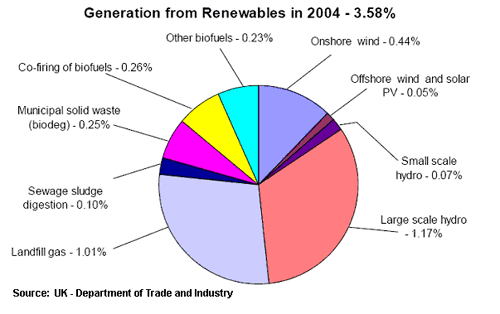Battery and Energy Technologies |
 |
|
Energy Resources
Despite the continuing developments of solar, wind and hydro power, over 80% of the World's electricity is still derived from heat sources. This page lists some the main sources of energy which are used for electrical power generation together with the energy content of the source. For a description of how electrical energy is generated from these sources and the conversion losses involved see the Electrical Energy Overview
Calorific Energy Content of Fuels and ChemicalsThe energy content of various materials usually, but not always, refers to the calorific or thermal energy which can be extracted from the material, usually by burning it and using the heat in some way to generate electricity.
Energy Sources:
Sources:UK National Physical Laboratories (NPL)UK Department for the Environment and Rural Affairs (DEFRA)Indian Ministry of Non-conventional Energy Resources (MNER)
Surprisingly, fossil fuels and even candy bars pack more energy than any of the explosives. This is because explosives, by definition contain both fuel and oxidiser while food and fossil fuels do not contain oxidiser and use air for combustion. The large volume of oxidiser necessary for complete combustion is typically much heavier than the fuel itself and taking the combined weight of the fuel plus its oxidiser into account would dramatically reduce its energy density (kWh/Kg) to below that of the explosives. The violent reaction of explosives occurs because the explosive is mixed with its oxidiser and burns throughout the full volume of the fuel, whereas fossil fuels can only burn at the surface where the fuel meets the oxidant.
[1] Note: 1 KiloWatthour (kWh) ≡ 3.6 MegaJoules (MJ) [2] Natural gas consists primarily of methane (70 to 90%) but includes significant quantities of ethane (5 to 15%), butane , propane , carbon dioxide , nitrogen , helium and hydrogen sulfide. [3] Hydrogen is not a primary energy source. It takes 50 kWh of electricity to produce 1 Kg of hydrogen by electrolysis.
Electrochemical Energy Content of Chemical SpeciesUsing the calorific energy content of various chemical substances and materials to generate electricity involves three energy conversion processes each of which introduces inefficiencies.
Chemical elements however contain intrinsic electrochemical energy potential associated with the energy of the electrons in the outermost electron shell or valence band (explained in the Energy section on the Cell Chemistries page) and this energy is converted directly to useable electric energy in batteries. The table of Electrode Potentials on the same page gives an indication of the relative magnitudes of these energies at the molecular level. The following table shows the magnitude of energy available from these sources when used in practical devices.
Energy Content of Naturally Occurring Energy FlowsThe ideal renewable energy sources are naturally occurring energy flows. The energy is free, but harvesting it could be very costly. The following table indicates some of the possibilities.
* After Garnish J. D. (1976) - Geothermal Energy (HMSO)To convert to alternative energy units - see the Conversion Table
Utilisation of Energy Resources for Electricity Generation
World Electricity Generation by Fuel (Terawatt hours - TWh)
Source OECD Factbook 2007 Note that electrical energy consumption has more than tripled from 5,200 to 17,400 TWh in 23 years. (17,400 TWh = 1,496 Mtoe) Over the same period the share of energy generated by nuclear power has shown the greatest growth with other renewables close behind, but the majority of the world's electrical power is still generated from coal.
Source OECD Factbook 2007
Fuel used for electricity generation in the UK
Electricity Generating Costs per MWh and kWh for Different Fuels
Source: The Institute for Energy Research (IER) and the US Energy Information Administration (EIA)
Levelised costs represent the present value of the total cost of building and operating a generating plant over its financial life, converted to equal annual payments and amortised over expected annual generation based on an assumed duty cycle. Decommissioning is not included. In the case of intermittent sources such as solar and wind the costs of maintaining and using standby capacity must be added. Summary of All Energy Sources and Uses for All Applications in the USA (Not Just for Electricity Generation)See Conversion Table to convert Quads to other units.
See also Energy Efficiency and Energy from Coal?
Return to Electrical Energy Overview
|
|||||||||||||||||||||||||||||||||||||||||||||||||||||||||||||||||||||||||||||||||||||||||||||||||||||||||||||||||||||||||||||||||||
![]() Print This Page || Home || FAQ || Site Map || Legal || Privacy Promise || Contacts
Print This Page || Home || FAQ || Site Map || Legal || Privacy Promise || Contacts
Woodbank Communications Ltd, South Crescent Road, Chester, CH4 7AU, (United Kingdom)
Copyright © Woodbank Communications Ltd 2005








